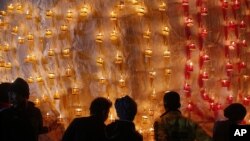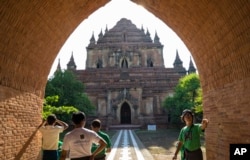When reforms began in Myanmar in 2011, its tourism sector was considered as one of those most likely to take advantage of the economic opportunities as the country looked to reconnect with the outside world.
Authorities and businesspeople were confident that foreign tourists would be drawn to Myanmar, eager to see such sites as the ancient temples of Bagan, the unique culture of Inle Lake, or the picturesque beaches overlooking the Bay of Bengal.
For a while it worked, as Myanmar’s international reputation improved in-line with the reforms happening at the time, the country was at the top of many visitors’ wish lists. Official figures showed that more than 4.68 million tourists visited the country in 2015, up from 816,000 in 2011. In 2017, 3.4 million tourists visited.
But the situation has changed again. The tourism sector has been heavily impacted by the crisis in Rakhine State, which has seen 700,000 Rohingya cross into Bangladesh to flee a brutal army crackdown. Myanmar’s military has been accused of ethnic cleansing the Rohingya, leading many tourists to stay away because of ethical concerns.
Myanmar’s government recognizes the need to take action, and in early August held a meeting for stakeholders to discuss what measures can be taken to improve the situation.
At that event, de facto leader Aung San Suu Kyi said the country should focus on measures such as improving rail and water transport, providing clean accommodation and developing more community-based tourism projects.
“Tourists can get many opportunities such as viewing the beautiful scenery and enjoying new experiences,” Aung San Suu Kyi said. “That is why roads, water ways and railways should be considered aside from air travel.”
Tourist operators in the country welcomed the remarks, but said that there are more short-term measures that can be made, and have also called for a nationwide strategic plan to tackle the malaise the industry is currently undergoing.
“What is needed is a comprehensive integrated approach from [the government] and the private sector to improve the tourism sector,” said Aung Kyaw Swar, former principal of the Inle Heritage Foundation. “This should include infrastructure, products, channels of communication, public relations, marketing and sales.”
He said he welcomed Aung San Suu Kyi’s speech, particularly the calls to improve infrastructure, but said a cohesive plan should be formed, including one that ensures that the respective ministries work closely together.
He also said that the government should invest in research teams, in order to effectively research potential clients’ expectations when they visit the country.
Foreign visitors to Myanmar have traditionally been drawn towards the major cities of Yangon and Mandalay, as well as Bagan and Inle Lake, but new destinations are emerging, and tourist development in lesser known areas could bring economic benefits.
U Bawla, a hotelier in Kale, the gateway to Chin State, one of Myanmar’s most scenic but underdeveloped regions, said that government support for tourism development would bring huge improvements for the lives of Chin people.
“When people come to Chin State, [they say] it is an amazing, and beautiful place,” he said, adding that only a handful of tourists visit each month. “I think that if the government concentrates on [developing tourism] in Chin State, that will bring many improvements for the Chin people, including improvements in roads and transportation.”
Bertie Lawson, managing director of Yangon-based Sampan Travel, said that Aung San Suu Kyi’s recommendations were “a good start”, but that much more needed to be done.
As examples, he highlighted the practice by domestic airlines of charging foreigners 25 to 40 percent more than Myanmar citizens, and the fact that buses to tourist destinations are often scheduled to arrive in the middle of the night, rather than at times more convenient for visitors.
“This might seem small and petty, but they add up and make people wonder if Myanmar is really worth it, when they could go elsewhere and not have to deal with this,” he told VOA.
“People aren’t complaining about the lack of CBT projects, or waterways. They’re complaining about the price, or about the issues they have traveling around the county. Those things can be changed, and should be looked at first,” he said.
Lawson said he believed the impact of the Rakhine crisis on tourism would likely be long-term, but said there was still reason to be optimistic.
“Repairing that reputation will take quite a long time,” he said. “I don’t think that means that tourism can’t do well, I just don’t think it will grow quite at the rate many were previously expecting.”







